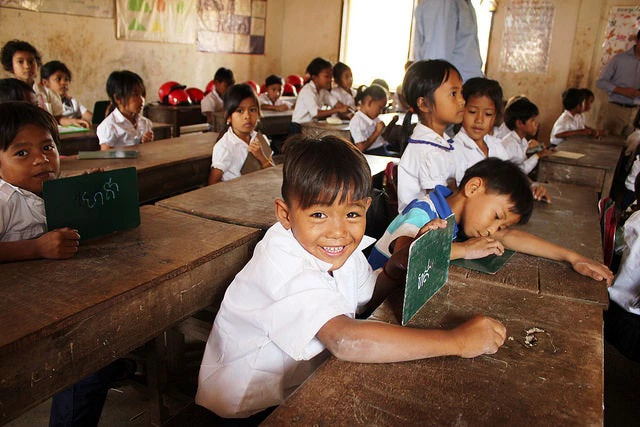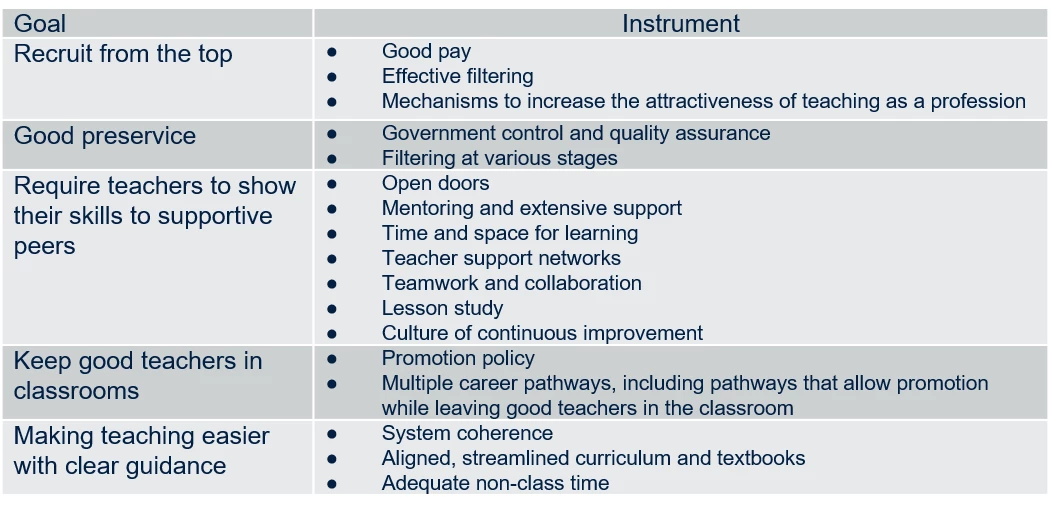
Among the 29 countries and economies of the East Asia and Pacific region, one finds some of the world’s most successful education systems. Seven out of the top 10 highest average scorers on internationally comparable tests such as PISA and TIMSS are from the region, with Japan, Republic of Korea, Singapore, and Hong Kong (China) consistently among the best.
But, more significantly, one also finds that great performance is not limited to school systems in the region’s high-income countries. School systems in middle-income Vietnam and China (specifically the provinces of Beijing, Shanghai, Jiangsu, and Guangdong) score better than the average OECD country, despite having much lower GDP per capita. What is more, scores from both China and Vietnam show that poor students are not being left behind. Students from the second-lowest income quintile score better than the average OECD student, and even the very poorest test takers outscore students from some wealthy countries. As the graph below shows, however, other countries in the region have yet to achieve similar results.
While some East Asian countries get top scores on PISA and TIMSS others have room to improve

What allows some countries to be so successful?
Our new education report on East Asia and the Pacific points to an answer. Countries with policies on equitable funding of schools, thoughtful use of assessment and exam data, active policies to promote readiness to learn, and strong institutional capacity, all seem to do well. Good policies in these areas put the conditions for learning in place and make it easier for teachers to be effective. Among the most crucially important policies are those that can comprehensively and supportively develop the skills of teachers.
What are some of these policies?
Recruit from the top. When the Republic of Korea and Singapore set out to build their education systems, they needed to staff up quickly. But once the basics were in place, both countries raised the bar on who could qualify to become a teacher. First, they recruited top university-level candidates to enter teacher training. Once completed, only the top share of graduates was offered jobs. Teaching became known as a destination for talented young people, and a prestigious profession.
Require teachers to show their skills in front of peers. A critical time for forming a good teacher is just at the start of their careers. In most successful countries in the region, new teachers must get in the habit of demonstrating how they teach in front of peers and future mentors. Teaching in the region has become an “open door” profession. Showing that they are getting better at the craft of teaching is part and parcel of advancing teachers’ career.
Give them clear guidance. While successful countries in East Asia and Pacific demand high qualifications and performance from teachers, they also give them much-needed support. Clear expectations on what to teach comes through clear textbooks and straightforward standards for learning. Compared with their peers in other OECD countries, teachers in many top performing countries in the region are given more time to prepare for each hour of class time.
Promote collaborations and peer feedback. When teachers feel isolated in their classrooms, schools and the whole education system struggle to get results. Top performers derive benefit from insisting that teachers work together, and build professional collaboration around continuous improvement. Shanghai’s “teacher research groups” epitomizes this approach: teachers come together to study ways to master their disciplines and more effectively deliver content.
Pay in a way that keeps the best teachers teaching and mentoring colleagues. Taking great pains to make a good teacher pays off most when that teacher stays in the classroom. In other regions, experienced teachers take administrative positions in large numbers. Successful countries in the region increase pay more steeply as teachers gain experience. Combined with merit-based advancement, teachers earn more comfortable compensation if they keep doing the hard work of teaching students.
Matching goals and instruments to create a demanding, supportive environment for teachers

Not all successful countries in East Asia and Pacific have all these policies in place, nor are they uniformly effective. Getting teacher policies right involves continuous refinement and adjustment of incentives and practices. Overall, however, the outstanding performance of many of the region’s students owes much to policies that demand much from teachers while providing them with a strongly supportive environment.
For these and other lessons from across the region, please check out our latest report here.


Join the Conversation